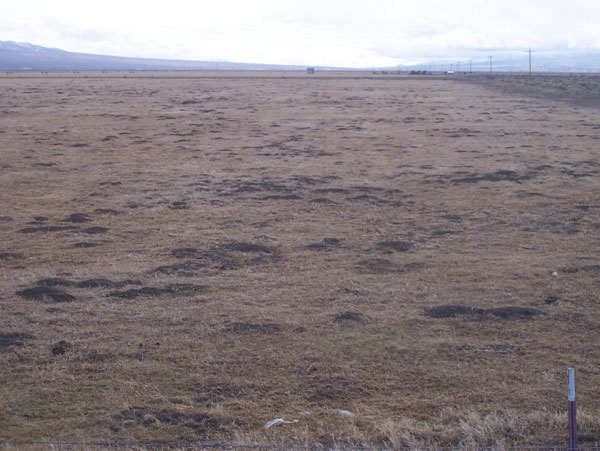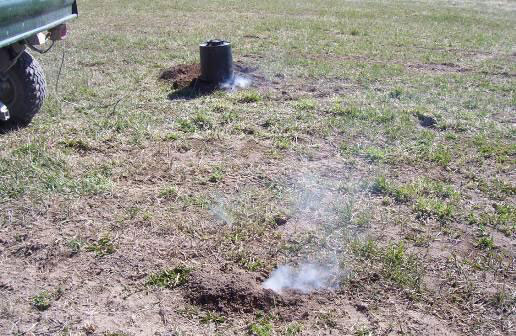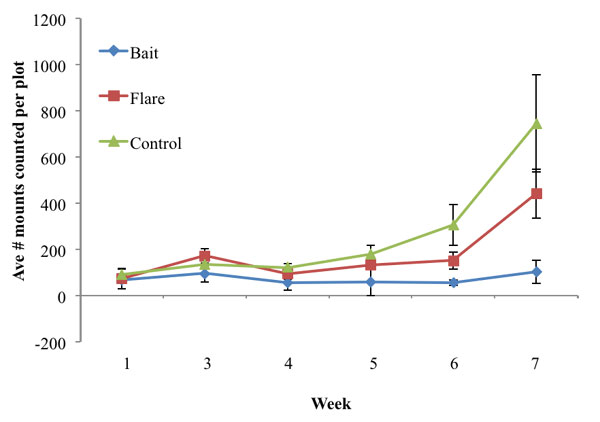 |
October 2012
|
October 2012 // Volume 50 // Number 5 // Research In Brief // v50-5rb9
A Case Study Involving Pocket Gopher Damage Abatement in Alfalfa
Abstract
Extension faculty mentored a local rancher to compare methods to control pocket gophers (Thomomys bottae) on his property. We compared the effectiveness of road flare fumigation to that of strychnine bait, which is the common method of pocket gopher control. The overall % change was highly variable among plots and treatment methods. Road flare fumigation is not recommended for hay fields because it was less cost-effective than commercially available 0.5% strychnine gopher bait and similar to no control at all. The faculty-and-farmer collaboration was a successful partnership to demonstrate research strategy and answer a management question.
Introduction
In the last decade there has been a call for the Cooperative Extension Service to renew its charge to empower and engage the rural community in research and science (Kelsey, 2002; Peters, 2002). The idea that Extension educators need to be better facilitators of knowledge exchange, and not merely delivery agents, is not new. The Kellogg Commission (1999) stated that the purpose of engagement was to encourage joint academic-community activities. In 2002, Kelsey made a plea that "space must be created for conducting research with the people not just for the people." In that vein, the Citizen Science movement of the last couple decades has spread across the country, with urban-centric programs such as the Master Naturalist and community volunteer efforts in research (ex: Cooper, Dickinson, Phillips, & Bonney, 2007; Thody, Held, Johnson, Marcus, & Brown, 2009).
An often-overlooked group of citizens is that of ranchers and farmers of the rural U.S. They often live far from towns and have work schedules that limit their ability to participate in larger, regularly scheduled Citizen Science type programs. Similar to urban citizens, when rural citizens are engaged in local research, they often develop ownership in the project and trust in the results. Furthermore, as trusted members of their community, when the results are shared with others, the participants often serve as sources of innovation for them.
Smith (1934) advocated "face-to-face, idea-by-idea" programs for faculty (i.e., Extension educators). The farmer should drive the question, hypotheses, data collection, and reporting, with the faculty assisting in research design, methods, and mentoring. These initial faculty-and-farmer projects may resemble pilot studies more than long-term projects. Here, the primary goal of the Extension educator is to foster success and collaboration for the future; the primary goal of the engaged citizen is to gain a needed answer to a question. The following is an example of collaboration between Extension and a rancher, as a result of a consultation about control methods for pocket gophers (Thomomys bottae). In this project, the Extension faculty assisted as essentially an "academic advisor," with the rancher conducting the study.
Background
Pocket gophers (Thomomys spp.) are common agricultural pests (Wiscomb & Messmer, 2010). The diet of gophers occupying an alfalfa field has been found to be over 90% alfalfa, even in mixed grass and alfalfa fields (Sullins & Sullivan, 2006). Pocket gopher burrowing activity can reduce the productivity of alfalfa fields and native grasslands by 20-50 % (Jones, Halpern, & Niederer, 2008). Furthermore, pocket gophers can change the plant species composition of a field when the soil mounds create an opportunity for weed seeds to germinate (Wiscomb & Messmer, 2010). Gopher mounds kill existing vegetation and create openings for colonization by competitively inferior plant species (Martinsen, Cushman, & Whitham, 1990). Romanach, Reichman, and Seabloom (2005) found that moist soil, such as irrigated fields, provides the vegetation needed for continued growth and activity of the gophers.
There are several registered toxicants available to farmers to control pocket gopher populations. However, toxicants can be costly, and an applicator's license is needed. Ranchers in Utah had learned of a method using road flares to fumigate gopher burrow systems from Arizona Cooperative Extension (Schalau, 2000; Schalau, 2001), but were unaware of the success of this method in the Intermountain West or on a commercial scale. Currently, there are no published data regarding the efficiency of using road flares to fumigate burrow systems. Therefore, we created a study to compare the effectiveness of the road flare method to decrease gopher activity to that of commercial bait on a hay pasture.
Methods
Study Area
The study area was an alfalfa field located in White Pine County, Nevada approximately 6 km west of McGill. The field measured 402 m X 805 m, totaling 0.32 km2 (80 acres) and was about 1920 m in elevation. Annual precipitation was 22 cm (US Climate Data, 2011). The soil was 0 - 25 cm of silt loam and 24 - 152 cm stratified silt loam to slity clay loam (Natural Resource Conservation Service, 2011). The average winter temperature was 0° C, the average summer temperature was 16° C, and the average annual temperature was 8° C (US Climate Data, 2011). The pocket gopher density in this field was high, with an ocular estimate of 1 gopher mound/2 m2 throughout the pasture (Figure 1).
Figure 1.
Photo of Study Plot Before Spring Digging by Pocket Gophers; the Mounds Present are From the Preceding Summer, White Pine County, Nevada, 2009

Site Preparation
The study plot was divided into nine sections of equal size, each approximately 0.04 km2 (8.87 acres). Each section was randomly assigned to one of three groups: 1) control group with no treatment given, 2) road flare fumigation, and 3) commercial 0.5% strychnine gopher bait (Fort Dodge Chemical, Inc., Lompoc, CA). Prior to spring gopher activity, we mechanically flattened all existing mounds in the study area using a roller pulled by a tractor. We measured and marked the plots directly in the study area, attaching flagging to fences and orange pin flags in the fields and at the corners of each study plot. Orange dashed-lines were sprayed on the ground to further delineate each plot. Treatment of the plots began April 3, 2009, when we observed increased pocket gopher activity concurrent with snowmelt. We administered the road flare fumigation treatment according to the method described by Arizona Extension (Schalau, 2001). For this method, we located and counted each mound, then exposed the tunnel within the mound and began treatment (Figure 2). When smoke from one flare exited other burrow openings at mounds, we did not apply treatment to those mounds; but they were counted and kicked down.
Figure 2.
Road Flare Fumigation Method Being Used. Smoke Exiting From Additional Tunnels Is Shown, Nevada, 2009.

To apply bait, we used a commercially available gopher bait probe; we pushed the probe into the ground in and around the mound until we found the main tunnel or chamber (UC IPM, 2009). Once the chamber was found, we administered approximately 2 grams of the poison bait into the chamber. The mound was then kicked down.
In the control plots, we counted and kicked down mounds without applying any treatment, to maintain consistency with the other methods. We revisited each plot weekly until May 16, 2009, to count the number of new mounds in each plot and apply the designated treatment to these new mounds. After this date, vegetation height impeded accurate counts of mounds, and we ended the study.
We calculated the average number of mounds counted in each plot (± 95% CI) for each week; in week 2 there was snow on the field and no data were collected. We used the following formula to calculate the percentage of change in the number of mounds counted in each treatment area: ((week n - week 1) / week 1)*100 = percentage change (± 95% CI). Due to the small sample size (n = 3 for each factor), we limited our analysis to basic statistics. Using Systat 11 (Systat Software, Inc., Redmond, CA), we calculated the average % change (± 95% CI) in the number of gopher mounds weekly and overall, for each treatment. Using the range of the confidence interval, we determined if treatments were statistically different from each other. For example, if the confidence interval bars just touched or overlapped, we concluded that the % change was not statistically different (Streiner, 1996).
Results
Control plots experienced an average of 722 ± 111.78% growth during the study (Figures 3, 4). Plots treated with flares experienced an average of 871.95 ± 913% growth during the study (Figures 3, 4). Finally, plots treated with poison bait experienced an average growth of 53.5 ± 63.6% (Figures 3, 4). While we were unable to conduct sophisticated statistical analyses on the data, by reviewing the confidence intervals of the data, we can conclude that plots treated with bait had lower weekly average number of gophers than other plots by the end of study. Those fields treated with road flare fumigation also had a lower average number of pocket gophers than the control plots.
Figure 3.
The Weekly Average Number of Mounds Counted (± 95% CI) Per Treatment Type

However, when we evaluate the overall % change in gopher numbers, the large variability of the average % change in growth for the road flare fumigation obscured our ability to draw conclusions regarding this method. Certainly, it appears that the bait method has less variability in its ability to control % change (i.e., growth in population) and thus may be more attractive as a result.
Figure 4.
Average % Change (± 95% CI) in Number of Gopher Mounds for Each Treatment

The commercial bait application was more cost effective than the flare method (Table 1). While we did not treat every mound with the road flare fumigation method, the cost of the flares was more expensive. Also, waiting for the flare treatment to have an effect and covering up the additional mounds required as much time as applying bait to each mound.
| Item | Cost/Mound | # Mounds | Applicator | Labor @ $15/hr | Total Cost |
| Road Flare | $0.60 | 1874 | $35 | $540 | $1700.00 |
| Bait | $0.02 | 1007 | $30 | $540 | $ 615.92 |
Discussion
Generally, damage due to gopher digging increases in the spring as the soil warms and again in the fall as juveniles disperse. Additionally, because the juveniles born in the winter leave the nest in the spring, a rise in the number of mounds of around 550% can be expected when an average of 5.5 juveniles leave the nest and begin digging (UC IPM, 2009). It is possible that gophers from control plots adjacent to other plots invaded those plots in order to avoid crowding and competition for food. This may explain why the flare plots experienced such variability in the % change calculations. Also, it is probable that the large jump in the number of mounds in the final week may have been a result of increasing numbers of juveniles leaving the nest and beginning to dig. A continued treatment effort might have resulted in the number of mounds decreasing after these juveniles were controlled.
Even with this sudden increase in gopher mounds, the 0.5% strychnine gopher bait may be a more effective control method. The plots treated with bait consistently had lower numbers of gophers throughout the study. Furthermore, the increase in numbers during the last week was minor, compared to the other two methods. This suggests that juvenile gophers ate the baits and therefore there was less dispersal with this method. Finally, the lower variability in the % change suggests that this method will have consistent results when repeated in subsequent seasons, compared to the road flare fumigation method.
This project was conducted for one spring season throughout the ranch, and control plots did experience damage during the study. The participant expressed concern over the idea of expanding the project to encompass more land or extend for a longer period of time, due to the costs of the damage incurred on the control plots. However, another option would be to cooperate with several ranchers simultaneously and across years to achieve the replication and robustness needed for a rigorous statistical analysis of the results.
Conclusions
The project described here successfully partnered an Extension faculty with a rancher interested in solving a damage control problem on his ranch, while implementing his own research. The results of the study indicated that strychnine bait was the more cost-effective method of control at a ranch scale. Road flare fumigation may be useful for controlling gophers in small areas because all the materials needed are easily accessible and it is somewhat effective; however, one should check the registered use of road flares before application. According to the rancher, this information will be passed on word-of-mouth by the rancher at hay symposiums, poison applicator license renewal meetings, and local workshops. Additionally, open access journals, such as the Journal of Extension appeal to some ranchers for accessing new information. The "idea-by-idea," or faculty-and-farmer, model is still an effective strategy for enabling Extension to help their constituents answer technical management questions in their region.
References
Cooper, C. B., Dickinson, J., Phillips, T., & Bonney, R. (2007). Citizen Science as a tool for conservation in residential ecosystems. Ecology and Society, 12(2), 11. Retrieved from: http://www.eologyandsociety.org/vol12/iss2/art11/
Jones, C. C., Halpern, C. B., & Niederer, J. (2008). Plant succession on gopher mounds in western cascade meadows: Consequences for species diversity and heterogeneity. American Midland Naturalist, 59, 275-286.
Kellogg Commission on the Future of State and Land-Grant Institutions. (1999). Returning to our roots: The engaged institution. Washington, DC: National Association of State Universities and Land-Grant Colleges. Retrieved from: http://www.aplu.org/NetCommunity/Document.Doc?id=183
Kelsey, K. D. (2002). What is old is new again: Cooperative Extension's role in democracy building through civic engagement. Journal of Extension [On-line], 40(4) Article 4COM1. Available at: http://www.joe.org/joe/2002august/comm1.php
Martinsen, G. D., Cushman, J. H., & Whitham, T. G. (1990). Impact of pocket gopher disturbance on plant species diversity in a shortgrass prairie. Oecologia, 83, 132-138.
National Resources Conservation Service. (2011) US Soil Survey. United States Department of Agriculture. Retrieved from: http://websoilsurvey.nrcs.usda.gov/
Peters, S. J. (2002). Rousing the people on the land: The roots of the educational organizing tradition in Extension work. Journal of Extension [On-line], 40(3) Article 3FEA1. Available at: http://www.joe.org/joe/2002june/a1.php
Romanach, S. S., Reichman, O. J., & Seabloom, E. W. (2005). Seasonal influences on burrowing activity of a subterranean rodent, Thomomys bottae. Journal of Zoology, 266, 319-325.
Schalau, J. (2000). Pocket gophers and a new control method. The Backyard Gardener. Arizona Cooperative Extension. Retrieved from: http://ag.arizona.edu/yavapai/anr/hort/byg/archive/pocketgopher2000.html
Schalau, J. (2001). Experimental pocket gopher control device. The Probe: Newsletter of the National Animal Damage Control Association, 215, 1-5.
Smith, C. B. (1934). Extension stands the test of time. Extension Service Review, 5(6), pp 82, 94.
Streiner, D. L. (1996). Maintaining standards: Differences between the standard deviation and standard error, and when to use each. Canadian Journal of Psychiatry, 41, 498-502.
Sullins, M., & Sullivan, D. (2006). Pocket gopher control techniques. Montana Department of Agriculture. Retrieved from: http://www.msuextension.org/ruralliving/Dream/PDF/PocketGophers.pdf
Thody, C. M., Held, R. J., Johnson, R. J., Marcus, J. F., & Brown, M. B. (2009). Grassroots conservation: Volunteers contribute to threatened and endangered species projects and foster a supportive public. Journal of Extension [On-line] 47(1) Article 1RIB3. Available at: http://www.joe.org/joe/2009february/rb3.php
US Climate Data. (2011). Climate McGill Nevada. Retrieved from: http://www.usclimatedata.com/climate.php?location=USNV0058
UC IPM Online (2009), Pocket gophers. University of California, Agriculture and Natural Resources, Statewide Integrated Pest Management Program, 7433. Retrieved from: http://www.ipm.ucdavis.edu/PMG/PESTNOTES/pn7433.html
Wiscomb, G. W., & Messmer, T. A. (2010). Pocket gophers. USU Extension Wildlife Damage Management Series. Retrieved from: http://extension.usu.edu/files/publications/publication/NR_WD_005.pdf




